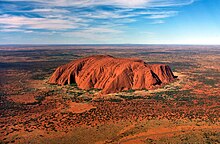Australia
| Commonwealth of Australia | |
|---|---|
 | |
| Capital | Canberra 35°18′29″S 149°07′28″E |
| Largest city | Sydney |
| National language | English[N 2] |
| Demonym |
|
| Government | Federalparliamentaryconstitutional monarchy |
| • Monarch | Elizabeth II |
| Sir Peter Cosgrove | |
| Malcolm Turnbull | |
| Barnaby Joyce | |
| Susan Kiefel | |
| Scott Ryan | |
| Tony Smith | |
| Legislature | Parliament |
| Senate | |
| House of Representatives | |
| Independence from the United Kingdom | |
| 1 January 1901 | |
| 9 October 1942 (with effect from 3 September 1939) | |
| 3 March 1986 | |
| Area | |
| • Total | 7,692,024 km2(2,969,907 sq mi) (6th) |
| • Water (%) | 0.76 |
| Population | |
| • 2018 estimate | 24,783,100[5] (51st) |
| • 2016 census | 23,401,892[6] |
| • Density | 3.2/km2 (8.3/sq mi) (236th) |
| GDP (PPP) | 2017 estimate |
| • Total | US$1.24 trillion[7] (19th) |
| • Per capita | US$49,882[7] (17th) |
| GDP (nominal) | 2017 estimate |
| • Total | US$1.39 trillion[7] (13th) |
| • Per capita | US$56,135[7] (10th) |
| Gini (2012) | 33.6[8] medium · 19th |
| HDI (2015) | very high · 2nd |
| Currency | Australian dollar (AUD) |
| Time zone | various[N 3](UTC+8 to +10.5) |
| • Summer (DST) | various[N 3] (UTC+8 to +11.5) |
| Date format | dd/mm/yyyy |
| Drives on the | left |
| Calling code | +61 |
| ISO 3166 code | AU |
| Internet TLD | .au |
Australia (/əˈstreɪliə/ (![]() listen), /ɒ-/),[10][11] officially the Commonwealth of Australia,[12] is a sovereign country comprising the mainland of the Australian continent, the island of Tasmania and numerous smaller islands. It is the largest country in Oceania and the world’s sixth-largest country by total area. The neighbouring countries are Papua New Guinea, Indonesia and East Timor to the north; the Solomon Islands and Vanuatu to the north-east; and New Zealand to the south-east. Australia’s capital is Canberra, and its largest urban area is Sydney.
listen), /ɒ-/),[10][11] officially the Commonwealth of Australia,[12] is a sovereign country comprising the mainland of the Australian continent, the island of Tasmania and numerous smaller islands. It is the largest country in Oceania and the world’s sixth-largest country by total area. The neighbouring countries are Papua New Guinea, Indonesia and East Timor to the north; the Solomon Islands and Vanuatu to the north-east; and New Zealand to the south-east. Australia’s capital is Canberra, and its largest urban area is Sydney.
For about 50,000 years[13] before the first British settlement in the late 18th century,[14][15] Australia was inhabited by indigenous Australians,[16] who spoke languages classifiable into roughly 250 groups.[17][18] After the European discovery of the continent by Dutch explorers in 1606, Australia’s eastern half was claimed by Great Britain in 1770 and initially settled through penal transportation to the colony of New South Wales from 26 January 1788. The population grew steadily in subsequent decades, and by the 1850s most of the continent had been explored and an additional five self-governing crown colonies established. On 1 January 1901, the six colonies federated, forming the Commonwealth of Australia. Australia has since maintained a stable liberal democratic political system that functions as a federalparliamentaryconstitutional monarchy comprising six states and several territories.
Australia has the world’s 13th-largest economy and tenth-highest per capita income (IMF).[19] With the second-highest human development index globally, the country ranks highly in quality of life, health, education, economic freedom, and civil liberties and political rights.[20] Australia is a member of the United Nations, G20, Commonwealth of Nations, ANZUS, Organisation for Economic Co-operation and Development (OECD), World Trade Organization, Asia-Pacific Economic Cooperation, and the Pacific Islands Forum. The population of 25 million[5] is highly urbanised and heavily concentrated on the eastern seaboard.[21] Australia has the world’s 9th largestimmigrant population, with immigrants accounting for 26% of the population.[22][23]
General characteristics
Australia’s landmass of 7,617,930 square kilometres (2,941,300 sq mi)[87] is on the Indo-Australian Plate. Surrounded by the Indian and Pacific oceans,[N 6] it is separated from Asia by the Arafura and Timor seas, with the Coral Sea lying off the Queensland coast, and the Tasman Sea lying between Australia and New Zealand. The world’s smallest continent[89] and sixth largest country by total area,[90] Australia—owing to its size and isolation—is often dubbed the “island continent”,[91] and is sometimes considered the world’s largest island.[92] Australia has 34,218 kilometres (21,262 mi) of coastline (excluding all offshore islands),[93] and claims an extensive Exclusive Economic Zone of 8,148,250 square kilometres (3,146,060 sq mi). This exclusive economic zone does not include the Australian Antarctic Territory.[94] Apart from Macquarie Island, Australia lies between latitudes 9° and 44°S, and longitudes 112° and 154°E.
The Great Barrier Reef, the world’s largest coral reef,[95] lies a short distance off the north-east coast and extends for over 2,000 kilometres (1,240 mi). Mount Augustus, claimed to be the world’s largest monolith,[96] is located in Western Australia. At 2,228 metres (7,310 ft), Mount Kosciuszko on the Great Dividing Range is the highest mountain on the Australian mainland. Even taller are Mawson Peak (at 2,745 metres or 9,006 feet), on the remote Australian territory of Heard Island, and, in the Australian Antarctic Territory, Mount McClintock and Mount Menzies, at 3,492 metres (11,457 ft) and 3,355 metres (11,007 ft) respectively.[97]
Australia’s size gives it a wide variety of landscapes, with tropical rainforests in the north-east, mountain ranges in the south-east, south-west and east, and dry desert in the centre.[98] It is the flattest continent,[99] with the oldest and least fertile soils;[100][101]desert or semi-arid land commonly known as the outback makes up by far the largest portion of land.[102]Australia is the driest inhabited continent; its annual rainfall averaged over continental area is less than 500 mm.[103] The population density, 2.8 inhabitants per square kilometre, is among the lowest in the world,[104] although a large proportion of the population lives along the temperate south-eastern coastline.[105]
Eastern Australia is marked by the Great Dividing Range, which runs parallel to the coast of Queensland, New South Wales and much of Victoria. The name is not strictly accurate, because parts of the range consist of low hills, and the highlands are typically no more than 1,600 metres (5,249 ft) in height.[106] The coastal uplands and a belt of Brigalow grasslands lie between the coast and the mountains, while inland of the dividing range are large areas of grassland.[106][107] These include the western plains of New South Wales, and the Einasleigh Uplands, Barkly Tableland, and Mulga Lands of inland Queensland. The northernmost point of the east coast is the tropical-rainforested Cape York Peninsula.[108][109][110][111]
The landscapes of the Top End and the Gulf Country—with their tropical climate—include forest, woodland, wetland, grassland, rainforest and desert.[112][113][114] At the north-west corner of the continent are the sandstone cliffs and gorges of The Kimberley, and below that the Pilbara. To the south of these and inland, lie more areas of grassland: the Ord Victoria Plain and the Western Australian Mulga shrublands.[115][116][117] At the heart of the country are the uplands of central Australia. Prominent features of the centre and south include Uluru (also known as Ayers Rock), the famous sandstone monolith, and the inland Simpson, Tirari and Sturt Stony, Gibson, Great Sandy, Tanami, and Great Victoria deserts, with the famous Nullarbor Plain on the southern coast.[118][119][120][121]
Climate
Climatic zones in Australia.[N 7]
| Equatorial Tropical Subtropical | Desert Grassland Temperate |
The climate of Australia is significantly influenced by ocean currents, including the Indian Ocean Dipole and the El Niño–Southern Oscillation, which is correlated with periodic drought, and the seasonal tropical low-pressure system that produces cyclones in northern Australia.[122][123] These factors cause rainfall to vary markedly from year to year. Much of the northern part of the country has a tropical, predominantly summer-rainfall (monsoon).[103] The south-west corner of the country has a Mediterranean climate.[124] The south-east ranges from oceanic (Tasmania and coastal Victoria) to humid subtropical (upper half of New South Wales). The interior is arid to semi-arid.[103]
According to the Bureau of Meteorology‘s 2011 Australian Climate Statement, Australia had lower than average temperatures in 2011 as a consequence of a La Niña weather pattern; however, “the country’s 10-year average continues to demonstrate the rising trend in temperatures, with 2002–2011 likely to rank in the top two warmest 10-year periods on record for Australia, at 0.52 °C (0.94 °F) above the long-term average”.[125] Furthermore, 2014 was Australia’s third warmest year since national temperature observations commenced in 1910.[126][127]Water restrictions are frequently in place in many regions and cities of Australia in response to chronic shortages due to urban population increases and localised drought.[128][129] Throughout much of the continent, major flooding regularly follows extended periods of drought, flushing out inland river systems, overflowing dams and inundating large inland flood plains, as occurred throughout Eastern Australia in 2010, 2011 and 2012 after the 2000s Australian drought.
Australia’s carbon dioxide emissions per capita are among the highest in the world, lower than those of only a few other industrialised nations.[130] A carbon tax was introduced in 2012 and helped to reduce Australia’s emissions but was scrapped in 2014 under the Liberal Government.[131] Since the carbon tax was repealed, emissions have again continued to rise.[132]
Content source: https://en.wikipedia.org/wiki/Australia









